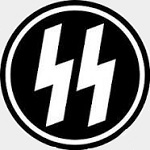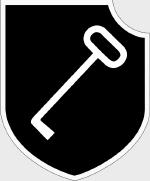Dragon DRR60236 German Sd. Kfz. 251 Ausf. D Half-Track - 1.SS Panzer Grenadier Divison "LSSAH", Kharkov, 1943 (1:72 Scale)
"We must do everything we can to promote anti-tank defense, and work just as hard to guarantee successful counter-attacks through the instrument of powerful tank forces of our own."
- Major-General Heinz Guderian, "Achtung Panzer!"
 The Sonderkraftfahrzeug (Sd. Kfz.) 251 half-track had its origins in the same requirement as the smaller and lighter Sd. Kfz. 250. Intended as an armored personnel carrier, the Sd. Kfz. 251 entered service in 1939, and quickly became the standard means of transport for the panzergrenadiers. As it turned out, the Sd. Kfz. 251 was an especially useful vehicle, not only capable of keeping up with the newly formed panzer divisions but also providing invaluable support as well. All told, there were 22 special-purpose variants built, including the menacing-looking Stukavoss ("infantry Stuka"), which mounted a series of rocket launchers on the outer sides of the vehicle. Other variants included a flame-thrower, anti-tank, and communications vehicle, as well as an observation post, ambulance, and infra-red searchlight carrier. Despite suffering from early reliability problems, the Sd. Kfz. 251 was produced by the thousands, eventually becoming a trademark of the German panzertruppe on all fronts.
The Sonderkraftfahrzeug (Sd. Kfz.) 251 half-track had its origins in the same requirement as the smaller and lighter Sd. Kfz. 250. Intended as an armored personnel carrier, the Sd. Kfz. 251 entered service in 1939, and quickly became the standard means of transport for the panzergrenadiers. As it turned out, the Sd. Kfz. 251 was an especially useful vehicle, not only capable of keeping up with the newly formed panzer divisions but also providing invaluable support as well. All told, there were 22 special-purpose variants built, including the menacing-looking Stukavoss ("infantry Stuka"), which mounted a series of rocket launchers on the outer sides of the vehicle. Other variants included a flame-thrower, anti-tank, and communications vehicle, as well as an observation post, ambulance, and infra-red searchlight carrier. Despite suffering from early reliability problems, the Sd. Kfz. 251 was produced by the thousands, eventually becoming a trademark of the German panzertruppe on all fronts.
This particular 1:72 scale replica of a Sd. Kfz. 251 half-track was attached to the Leibstandarte Adolf Hitler Panzer Grenadier Division and is painted in a stunning winter camouflage scheme.
Sold Out!
Dimensions:
Length: 3-inches
Width: 1-inch
Release Date: October 2006
 Historical Account: "Soldiers of Destruction" - SS-Panzer Division Leibstandarte Adolf Hitler (LAH) was formed on March 17th, 1933, by Josef "Sepp" Dietrich, Hitler's bodyguard, on the order of der Fuhrer who wanted a full-time armed force that was completely loyal to him. It was attached to Heeresgruppe Sud during the invasion of Poland and later took part in the invasion of France and the Low Countries. For the most part LAH was held in reserve although it was employed against retreating British troops trapped at Dunkirk. After the British capitulation, it was attached to XIV Armeekorps during the second and final phase of the invasion of France. Following the armistice, LAH was upgraded to a brigade and began training for the planned invasion of Britain (Operation Seelowe). When the invasion was cancelled, LAH was transferred to Romania for the Balkan invasion. It fought its way through Yugoslavia and Greece chasing Allied troops to Kalamata, where they were evacuated by sea to Crete. LAH was attached to Heeresgruppe Sud during the initial stages of Operation: Barbarossa, seeing action at Kiev and again at the Black Sea port of Rostov. It was transferred to France for refitting in 1942 and was upgraded again, this time to a Panzergrenadier Division. It returned to the Eastern front the following year, fighting at Kharkov and then at Kursk during Operation Citadel. After Kursk, LAH was sent to Italy to perform anti-partisan duties but was soon returned to the Eastern front, this time as a full-fledged Panzer Division. Following the debacle at Kamenets-Podolsk, it was sent to France for rest and refit.
Historical Account: "Soldiers of Destruction" - SS-Panzer Division Leibstandarte Adolf Hitler (LAH) was formed on March 17th, 1933, by Josef "Sepp" Dietrich, Hitler's bodyguard, on the order of der Fuhrer who wanted a full-time armed force that was completely loyal to him. It was attached to Heeresgruppe Sud during the invasion of Poland and later took part in the invasion of France and the Low Countries. For the most part LAH was held in reserve although it was employed against retreating British troops trapped at Dunkirk. After the British capitulation, it was attached to XIV Armeekorps during the second and final phase of the invasion of France. Following the armistice, LAH was upgraded to a brigade and began training for the planned invasion of Britain (Operation Seelowe). When the invasion was cancelled, LAH was transferred to Romania for the Balkan invasion. It fought its way through Yugoslavia and Greece chasing Allied troops to Kalamata, where they were evacuated by sea to Crete. LAH was attached to Heeresgruppe Sud during the initial stages of Operation: Barbarossa, seeing action at Kiev and again at the Black Sea port of Rostov. It was transferred to France for refitting in 1942 and was upgraded again, this time to a Panzergrenadier Division. It returned to the Eastern front the following year, fighting at Kharkov and then at Kursk during Operation Citadel. After Kursk, LAH was sent to Italy to perform anti-partisan duties but was soon returned to the Eastern front, this time as a full-fledged Panzer Division. Following the debacle at Kamenets-Podolsk, it was sent to France for rest and refit.
LAH fought in Normandy following the Allied invasion and saw action at Caen, Falaise, and Aachen as it fell back on the German frontier. It participated in the Ardennes counteroffensive (
Unternehmen Wacht am Rhein) where it was attached to I SS Panzerkorps. Later on, LAH was sent back to the Eastern front to help break the siege of Budapest (Unternehmen Margarethe). Afterwards, it was transferred to Austria where it surrendered to American troops at war's end.


